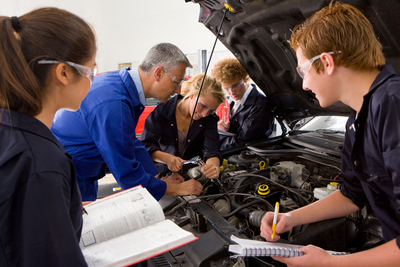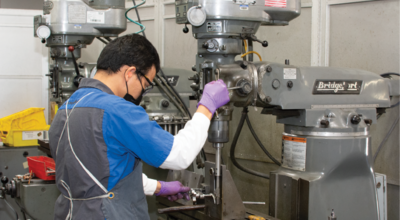BUSINESS
The Changing Aftermarket Workplace
How Industry Businesses Are Reimagining Operations to Embrace “The New Normal”
By Mike Imlay

The COVID-19 shutdowns accelerated the trend of remote work throughout the aftermarket. Companies quickly learned it has numerous benefits, including a rise in productivity, the ability to recruit from a wider talent pool, and an increase in employee retention.
The recent pandemic upended so many aspects of people’s daily lives, it’s nearly impossible to list them all. Among the most glaring is the transformation of the American workplace. In many ways, the COVID-19 disruptions accelerated several employment trends already taking shape. But they also forced companies to make unexpected adjustments that may be with us for years to come.
Like other industries, specialty-equipment businesses are now contending with what’s been dubbed “The Great Resignation” and an increasing labor shortage, changing workplace demographics and company cultures, rising salary and compensation expectations, and new technologies designed to better manage employees and enhance productivity. And, while everyone is talking about a “new normal,” there’s no precise definition of what that “normal” might be.
“To retain employees today, employers must not operate under the premise that they are waiting to ‘get back to normal’ or even a ‘new normal,” said Lisa Sanchez, SPHR, SHRM-SCP, CPLC. A leading expert and frequent presenter on human resource topics, Sanchez is the vice president of employee experience and engagement at ArtCenter College of Design, an institution known throughout the world for its automotive design program. She believes that all workplaces are facing “a new day and a new way.” The most successful company cultures will emphasize work-life integration, flexible and hybrid scheduling, employee wellness, and work-from-anywhere solutions.
“The Great Resignation is definitely real,” she continued. “It is reported that 4.5 million people left their jobs as of November 2021. The COVID-19 pandemic gave people time for pause.”
The result was a massive reflection on what matters most in life. “This led people to find jobs that align with [their] new values, leave jobs without a place to go, start entrepreneurial projects, go back to school or start a new career altogether,” she explained.
Going Remote
Of course, amid lockdowns and employee resignations, the nature of work itself also changed dramatically.
“I think like everyone when the pandemic hit, we were taken a little off guard and had to pivot very quickly to ensure the safety of our people,” said Krista Lamb, DeatschWerks director of products and customer experience.
That pivot meant setting up many office employees to work remotely through a secure VPN. The company also provided any computers and equipment needed for home work stations. Those urgent measures proved so productive that DeatschWerks decided to continue the practice after stay-at-home orders were lifted.
“There are several positions that we are completely willing to have 100% remote,” explained Lamb. “They only come in once a quarter for meetings versus coming in for face-to-face meetings all the time. Connecting with people via Zoom has made one-on-one and team meetings easier [than] everyone sitting in a room. With respect to work productivity, we found that in a remote environment, employees were still productive, if not more so.”
Like many aftermarket companies, DeatschWerks also discovered another benefit of remote setups: the ability to recruit new talent far beyond the company’s Oklahoma City base.
“In our space, having a proficient understanding of the industry, the passion and enthusiasm of our customer base, different motorsports, and how to reach all those people is a specialty skill set. Having the ability now to say we’ll take top talent and we don’t care where they work offers a huge opportunity to recruit [beyond] our metropolitan area,” observed Lamb.
Although Sanchez is also a proponent of the trend, she cautioned that the shift toward remote work isn’t alway easy.
“The legalities become complicated because employers have to pay according to each state’s employment laws and follow other laws such as workers’ compensation and leaves of absence,” she said. Sanchez added that although employees generally like remote work, they do miss “water-cooler experiences, hallway conversations and in-person collaboration.
“What I like to focus on is not getting people back to their cubicles and offices, but how we engage our workforce in a different way while recognizing that we have employees on-ground and virtually. It is definitely a mindset shift,” she noted.
“Managing a virtual team is not the same as being able to walk around and sit and talk with the people that you’re working with,” agreed Lamb. “It’s a little different of a skill set, and learning how to touch base and manage the workload when you’re not in the same room together requires having the proper tool sets in place.”
For DeatschWerks that meant an entrepreneurial operating system and specialized software to manage meetings, track projects and deliverables, and stay in virtual touch with employees. Of course a strong server structure—complete with optimized security, firewall and VPN—goes without saying.
Rethinking Company Culture

The continuing labor shortage has specialty-equipment companies stepping up their youth recruitment efforts, partnering with local schools and colleges and transforming their company cultures to better appeal to a next-gen workforce.
According to Sanchez, remote work can also yield cost savings. Many businesses are now downsizing facilities, freeing up space for multipurpose work areas, and introducing shared work stations for employees who come and go throughout the week. In the process, they’re also reassessing equipment and utility needs accordingly.
But “reimagining” workplaces also requires rethinking a company’s culture and management style. “Today, we say people don’t leave their companies; they leave toxic cultures. Management and leadership need skills on being empathetic, inclusive and flexible leaders to adapt to a diverse workforce with a variety of needs,” explained Sanchez.
Building an inclusive company culture can be especially challenging for businesses with production facilities and workers who must be physically present even as others “get to work from home.” Sanchez said recognizing and showing appreciation for each worker’s contributions is a key to maintaining a harmonious environment.
“What we don’t want [managers] to do is to ignore or forget about the people who don’t come to the premises as often,” she said. “Managers and leaders really have to find a way to recognize employees for the work they do in both work methods.”
“For example, no one should miss out on a well-deserved promotion just because they are not seen in the office. Or how do we create a sense of belonging if someone works remotely in Texas and the worksite is in California? Engagement will require more attention to ensure that on-ground and remote employees have meaningful experiences, but they obviously can’t be the same. Equity does not mean the same. Employee resource groups, no-agenda connection meetings, wellness challenges, and virtual employee celebrations are ways to create community,” she explained.
Thanks to a competitive labor pool and inflationary pressures on consumers, more and more companies are conveying that recognition through salary hikes and other benefits. A case in point is Forgeline Motorsports, headquartered in Dayton, Ohio.
“The average inflation number that everybody has been giving for the last month or two has been 7%, so we just gave the entire shop a 7% raise recently. Nobody is asking, but you don’t know if they’re looking,” said David Schardt, the company’s president. “We do realize that they’re having to spend a lot more money, and the money they made three months ago isn’t the same money they’re making today. I can honestly tell you, some of our people were almost in tears. They just thought it was the greatest thing.”
Beyond a competitive salary, Forgeline offers its employees a dynamic company culture. “We’ve always included the employees in almost all our decisions,” Schardt explained. “We have weekly lunches where we tell everybody what’s going on. We ask their opinion on the things that we’re doing every single lunch we have. I ask, ‘What can I do to make your job easier? I don’t want you to hate your job.’ If somebody feels like we can make something easier, I’m willing to invest.”
Forgeline also organizes regular golf, go-karting and other family-oriented outings for employees. The company Christmas party traditionally sees Forgeline co-owner and Global Sales Manager Steve Schardt playing Santa with gifts for its employees’ kids based on wish lists submitted beforehand.
“Both Steve and I also spend a lot of time out in the shop,” added Schardt. “I’m there every day, at least for an hour or two, just talking to the employees, helping them and being involved in what they’re doing. I think they feel comfortable coming into my office and asking me for something or asking me a question when I’m out in the shop. I think it’s important to know everyone personally as well. If you have 500 or 1,000 employees you can’t do that, but your managers could.”
All this helped Forgeline maintain employee loyalty throughout the pandemic. Faced with a shutdown early on, Forgeline had to lay off half its workforce. When business surged again six weeks later, the company had no difficulties bringing back the crew.
“We were really worried that some people might have been upset they got selected for layoff and found another job. But we invited everyone to come back and they did happily,” said Schardt.
Addition and Subtraction

At the height of the pandemic, aftermarket companies often spread workers out on shop floors or added new shifts to maintain social distancing and safety. For many, such adaptations will likely continue even after COVID-19 subsides.
Necessity being the mother of invention, the pandemic also accelerated numerous other changes in aftermarket production facilities. To maintain social distancing amid a surge in consumer demand for product, many companies spread out their machine and assembly stations and added second or even third shifts.
“We started two shifts during the pandemic and I think it really helped keep people safe and healthy,” said Aldan American owner and President Garrett Harmola, who also faced the challenge of moving his company into a new Signal Hill, California, facility in 2021. “Now as we move into our new location we’ve built out our workstations and laid out our office to keep folks spread out a little bit more. Things are more streamlined than they may have been prior to the pandemic.”
Still, like other aftermarket businesses, Aldan American has faced challenges finding workers to fill its new facilities. Much has been written about the graying aftermarket and tight labor supply, with Baby Boomers retiring and employees of all ages joining The Great Resignation. Harmola’s solution: recruit young talent through a local high school.
“A lot of our team started off from high school automotive programs,” said Harmola, who has turned to automotive instructors for referrals. “When these younger automotive enthusiasts come in, they also have friends that are maybe going to a technical school or doing some college in the local area. So we’ve really built out our team. Some of these folks are now running whole departments, whether it be shipping or overseeing production or subassemblies or even just warehousing.”
Harmola added that fielding a younger team has required some workplace
flexibility, including the addition of a second shift to enable students to continue their schooling. “A lot of our subcomponents and orders are built and shipped during the day, and then night is spent restocking, kind of like a grocery store. But we’re still a small-knit, fast-moving group. With the older, more experienced roles and so forth, it’s a good mix. We all have an eye on the goal of growing and scaling and producing high-quality product.”
Many aftermarket companies are also looking at technological enhancements to address the changing labor market. Among them is Michigan-based MAHLE Aftermarket North America, which recently partnered with Kardex to bring AutoStore robotics into MAHLE’s master distribution center in Olive Branch, Mississippi.
“It’s a changing workplace for sure. We’re almost completely remote on the office side,” said Ted Hughes, director of marketing for MAHLE Aftermarket North America. “On the warehouse side, an increase and investment in technology is mandatory because the pandemic has brought about this labor shortage.”
Hughes noted that distribution center staff can easily walk miles a day to pull parts and product. The new robotics ease the burden on workers by finding and retrieving parts for them, bringing them multiple orders at a time.
“We’re not bringing in robots to replace people; we’re coming to grips with the fact that we’re never going to have the people structure that we had before,” said Hughes. He added that the new system required a sizable investment, but cost analysis has shown the robotics technology will quickly pay for itself.
Sanchez noted that changing age demographics also raise several human resource issues. “We should be proactive by understanding our demographics to learn what percentage of the population is retirement-ready,” she explained. “Once we know that, we can strategize succession planning. If we truly believe that Gens Y and Z are the future presence of the workforce and will be in management positions, how are we charting their leadership journey?”
“Another very important question is, ‘Are their voices and presence invisible on leadership teams?’” she continued. “If so, future planning is being done in a vacuum and without the right voices at the table… The future of work is tapping into talent from a diverse workforce and positioning the organization and culture for success.”
According to Sanchez, today’s human resource structures are quickly moving away from the “one size fits all” philosophy of prior eras. “We must have a variety of programs to meet a variety of diverse needs. The younger generation is tech savvy. They learn differently. They want information that is fast and at their fingertips. This is probably not the same for Baby Boomers. The veterans probably still want to write letters or pick up the phone and call someone. And if organizations don’t understand this and adapt, the impact will be felt in retention, disengagement and low morale.”
Sanchez added that the pandemic has also brought heightened attention to issues of workplace safety, diversity and inclusion. Moreover, lockdowns changed how people see themselves personally and socially. For many, especially the younger generation, The Great Resignation has been about finding workplaces where they can fit in, be themselves, embrace their passions and pursue learning and personal growth. She predicted that workplaces that offer educational opportunities and access to personal enrichment programs will gain an increasing edge in employee recruitment and retention.
“We used to say, ‘When you come to work, leave your problems at the door,” Sanchez explained. “That is the human resources of yesterday and nevermore. People come to work with all their lived experiences. As human resource practitioners, we must pay attention to this.”
Perhaps a recent MIT Sloan Management Review/Deloitte report put it best in advising business managers to think less in terms of traditional workplace models and more along the lines of workforce ecosystems. Entitled “Workforce Ecosystems: A New Strategic Approach to the Future of Work,” the report noted that such ecosystems increasingly rely on a mix of on-site and remote employees, “gig” workers and other contractors. In this environment, corporate departments are giving way to team-based models that tap all sorts of contributors to get a project done.
According to the report, “This new, more holistic view of workforce management provides executives with new perspectives and flips a perennial strategic question. Instead of asking, ‘How can my workforce support my strategy?’ Leaders can ask, ‘What strategies become possible with my workforce ecosystem?’”
Based on her own observations of today’s evolving business culture, Sanchez agreed that workplaces are becoming more collaborative than ever. “I have seen an increase in team members working on task forces, committees and work teams where they pull the talent that they need to work on projects,” she said.
“It takes away from this idea of silos where people feel ownership of their department—that it’s what they work on and nobody else gets to touch it. You have to bring in partners and collaborators because at the end of the day, we all are still traveling down the exact same road, working for the same company, to achieve the mission and goals.”






